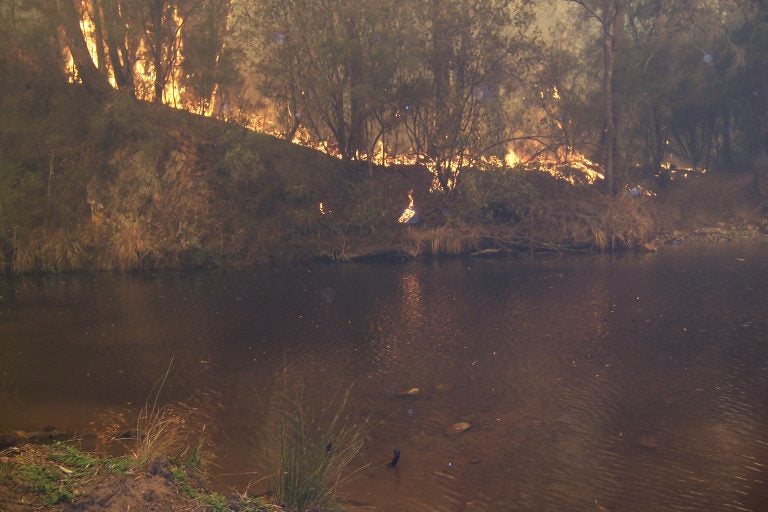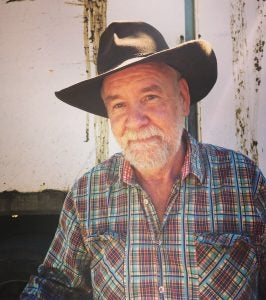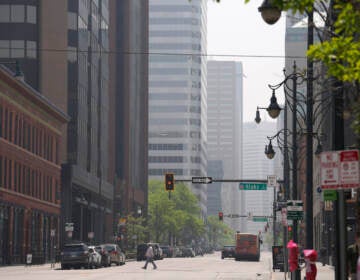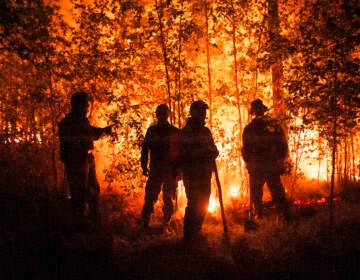As bushfire approached, this Australian rancher fought fire with fire
When flames started to burn down the hill toward his family ranch, Charlie Lovick saw his chance: He kept a cool head and took action.
Listen 04:01
A fire burns along the Howqua River in 2006 in southern Australia's Victoria state. Fire is no stranger in the bush country there. (Graeme Stoney, Mountain Cattlemen's Association of Victoria)
Charlie Lovick is the fifth generation of Lovicks to raise cows in the Howqua Hills of southern Australia.
When fire comes, it rips through the forests of eucalyptus and gum trees — scorching homes and livestock.
Lovick’s fire story takes place back in 2006. It was a bad year for fires, and the bush was burning 10 miles away from Lovick’s ranch.
“We had one to our north and one to our south, and the authority said, ‘It’s in the bush, it’s no worries.’ We’re saying, ‘No, if it gets in below us on the river system, it’ll take us,’ ” he said.
“Fire’s a mischievous thing. It works out how to do stuff, I reckon.”

Lovick has a gray beard and bright blue eyes with a roguish twinkle.
He’s lived here all his life, and he knows this land, and the unique weather patterns here, better than just about anyone.
“So, lo and behold, yes, the fire did go south, southwest. And we knew it was coming. You could hear it. And you could see the glow every night,” Lovick said.
It was like a “red front” was bearing down on them, he remembered.
Local authorities told the family to evacuate — if they stayed, no one would come to save them. But Lovick and some of his close friends and neighbors decided to defend their properties, which sit in a little valley surrounded by forested hills.
Local authorities left a couple bulldozers, so the neighbors cleared strips of bare land — called fire breaks — around their properties. But they had no idea if it would make a difference.
They watched the fire anxiously through the night, knowing it could move down the hillside toward them. Around 1 o’clock in the morning, Lovick said, he saw his chance.
“The country got a little bit damp and a little bit doughy, so it wasn’t burning so strong, and that was a great opportunity for us to set the fire,” he said.
He decided to fight fire with fire. Friends and neighbors walked through the forest below the encroaching fire using torches to light a separate fire. The hope was their fire would burn up the valley walls, and rob the big fire of its fuel.
It’s called back-burning.
“It’s gotta be done right. If the weather patterns are the wrong way, you’re going to light a fire and it’s gonna to burn you,” Lovick said.
He broke the law when he started lighting the forest on fire, but he knew there wasn’t time to ask permission.
“We had a small window of opportunity, and being bushmen, you grab that straight away,” he said.
“We waited for the fire to come down off those ranges up there. It got about a third of the way down, and we thought, if we don’t light this, the fire will beat us. So we need to light it at a particular time, so it can burn back and snuff that fire out about halfway down the range. And it worked perfectly,” Lovick said.
The back-burn did its job.
“I think the younger people hadn’t seen something like that happen before. They were just amazed how bloody simple it was, if you do it the right way at the right time,” Lovick said.
“So, it only took an hour. At 2 o’clock, we were sitting down on the road where we lit it, having a couple of cold beers. As you would.”
WHYY is your source for fact-based, in-depth journalism and information. As a nonprofit organization, we rely on financial support from readers like you. Please give today.






